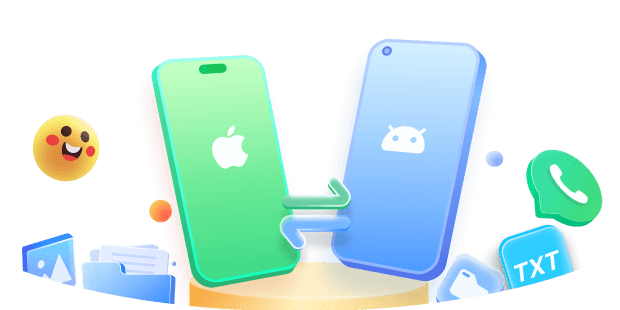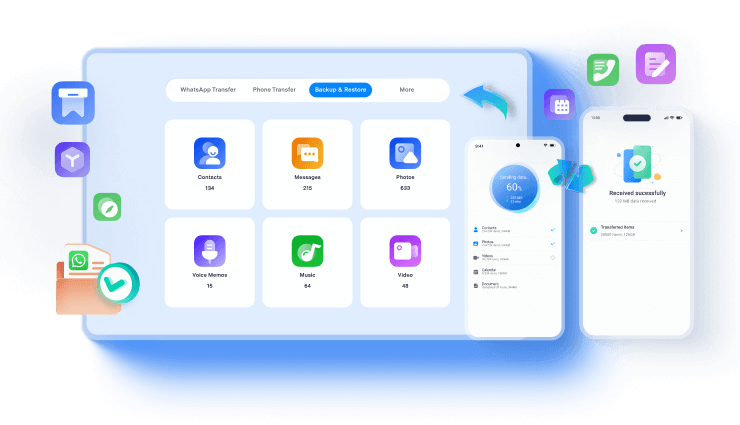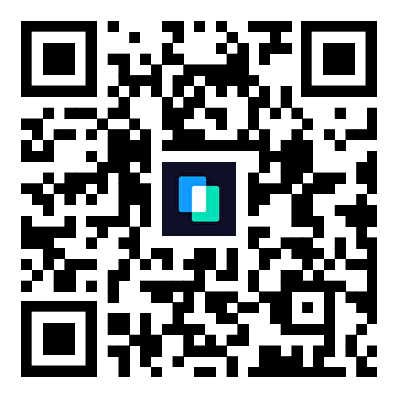Sharing private chats with personal photos or sensitive content is common these days. However, once the media is sent, there is no guarantee that it will remain safe or could stay forever on someone else's phone. Consequently, users look for safer ways to send such content without it being saved or forwarded. To address this, WhatsApp added a feature that allows you to send media that disappears after being viewed.
If you are still unsure about how the 'View Once' message WhatsApp option works and why it matters, continue reading this article. Here, you will explore the feature’s privacy benefits along with tutorials regarding how to use it on both Android and iOS. Additionally, you will learn about an advanced tool that helps users recover view-once media files even if they are unavailable.
In this article
Part 1: Overview of the View Once Message WhatsApp Feature
With growing concerns about digital privacy, this feature helps control what others can do with shared content. Once you send anything via view-once, you will not be able to preview it again. Most importantly, this WhatsApp message view once feature blocks screenshots from the viewer's end while the media is opened. If users have sent media in this way, the receiver must open it within 14 days; otherwise, it will expire.

Additionally, if the receiver has read receipts turned on, you can see if they have viewed it. Once the receiver has viewed the content, it won’t be saved to their gallery. However, if the file remains unopened during a backup, it may be recovered later. Still, once it’s opened, it won’t show up in any backups, making this medium secure and protected.
Part 2: Major Privacy Benefits of WhatsApp View Once Message
Now that you understand how the feature works let's explore why it matters in honest conversations. Read below to find out what benefits this one-time view message WhatsApp offers for users:
- Limited Unwanted Saving: The media disappears after being viewed once, so it can't be saved or downloaded to the recipient's device. This helps keep personal videos or photos from being stored without any permission and creates a safer space for temporary sharing.
- Block Screen Capture: The app does not allow users to take screenshots or screen recordings of the view once media is playing. This adds an extra layer of protection by making the screen black if someone attempts to copy the content.
- Improve Message Control: WhatsApp has an external rule that removes unopened view once media from the chat after 14 days. This expiration helps protect your privacy by ensuring shared content does not remain accessible for an unlimited time.
- Remove Digital Trace: Since the media is not saved or backed up after being viewed, no record remains in the chat. This reduces the risk of someone accidentally finding or misusing the shared content later and supports more private communication.
- Supports Temporary Sharing: It's perfect for sending quick information, such as passwords or sensitive notes, that don't need to be saved. This feature helps users share content without worrying that it might stay in others' chats forever.
Part 3: How to Send One-Time View Message WhatsApp on Android and iOS
Sharing sensitive media without leaving a trace is now easier with WhatsApp's privacy feature. Simply by selecting the media from the gallery, users can tap the "View once" icon beside the text box to share data securely. Unlike regular sharing, as discussed above, it won’t be saved or forwarded once it’s opened. So, to know how view once text WhatsApp works on Android and iPhone, follow the guides below:
For Android
Instruction. From your WhatsApp, navigate to any conversation to select the "Camera" icon in the field labeled "Message," On the next screen, you can either take a fresh pic or choose the "Gallery" icon to browse your library. Afterward, tap the View Once icon with the "1" on it, and then select the "Send" button.
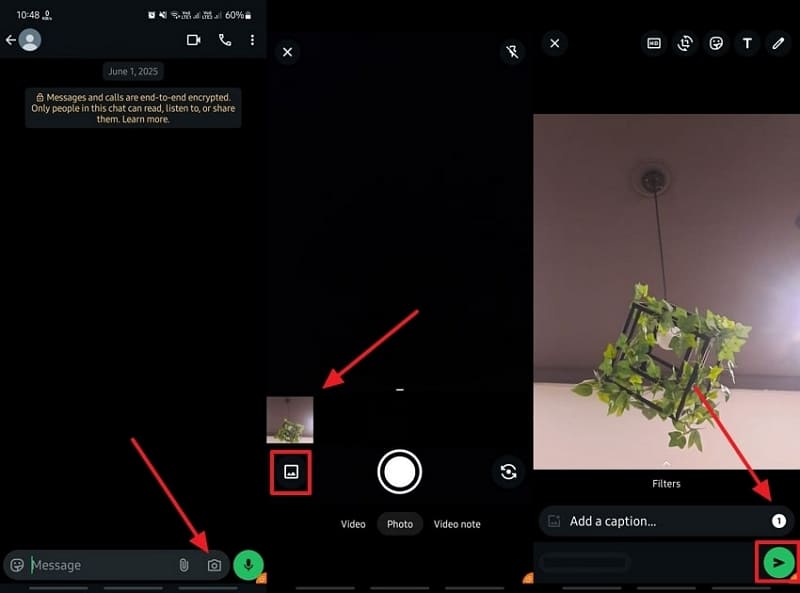
For iPhone
Instructions. Select any conversation from the WhatsApp main interface and tap the "Camera" icon in the bottom right corner. Then, take a new photo or choose one from “Photos” to proceed. Following that, select the "1" icon near the caption to enable the view once option, and then click the "Send" button to share it.
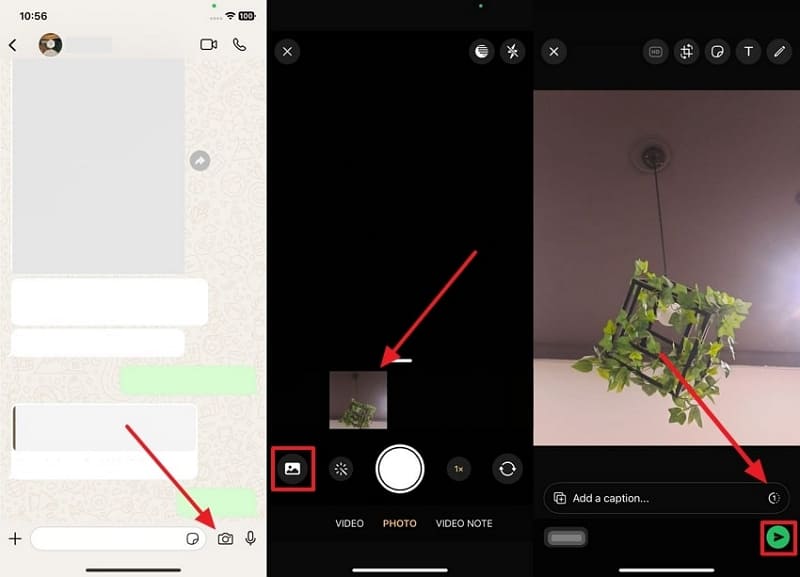
Pro Tip: Perfect Approach to View WhatsApp Messages Multiple Times
Imagine receiving a one-time view of the media from others and opening it without paying full attention, only for it to disappear instantly. Since WhatsApp's view once message cannot be replayed, this can be pretty unpleasant. That's where MobileTrans comes in, enabling you to preview the lost message again. Users found this tool very helpful as it can retrieve essential videos or photos that are shared in the temporary view.
The tool makes it easier to recover WhatsApp view once media, including photos and videos, and save them permanently to your device. It offers a preview feature that allows users to view the media before deciding to recover it. Users need to link their messaging app to the tool, and it can help them retrieve deleted or lost content in seconds.
Simple Guide to View Once Message WhatsApp Multiple Times
Adhere to the simplified instructions detailed below and find out how to retrieve WhatsApp message view once:
Step 1. Access the App to Initiate the Process of Recovery
After the tool has been launched, navigate to the "WhatsApp Recovery" section on the left side and select "View Once Recovery." Once the feature opens, hit the "Start Recovery" option to commence the process.
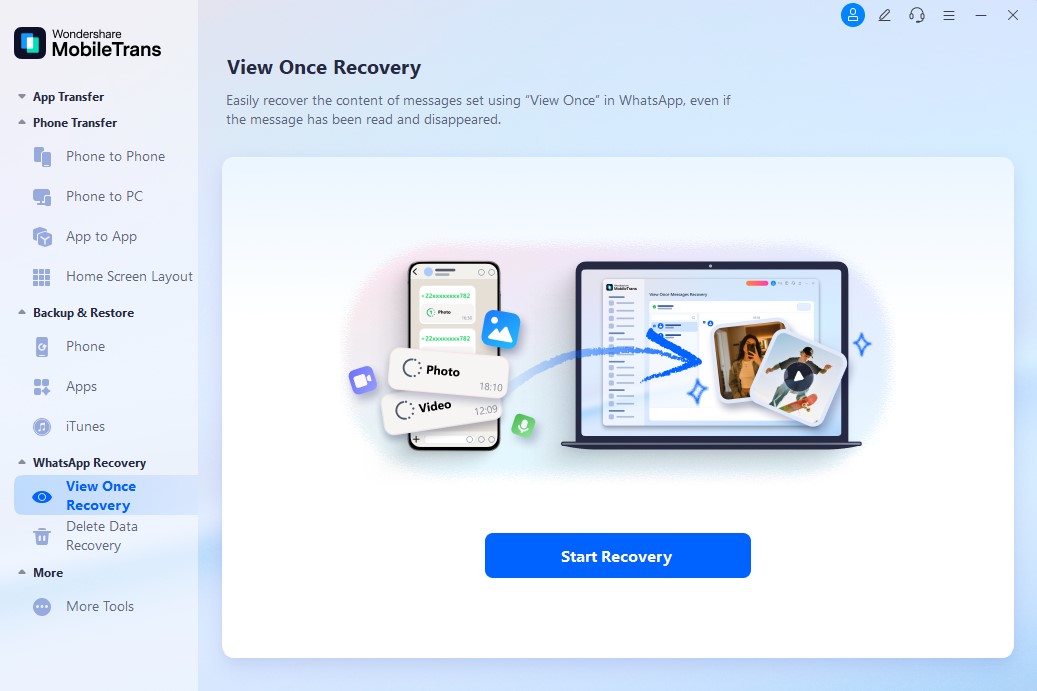
Step 2. Utilize the QR Code to Create a Link With Your Phone
Following that, the next window will open with a “QR Code” in it. Connect your mobile with the tool by following the on-screen instructions.
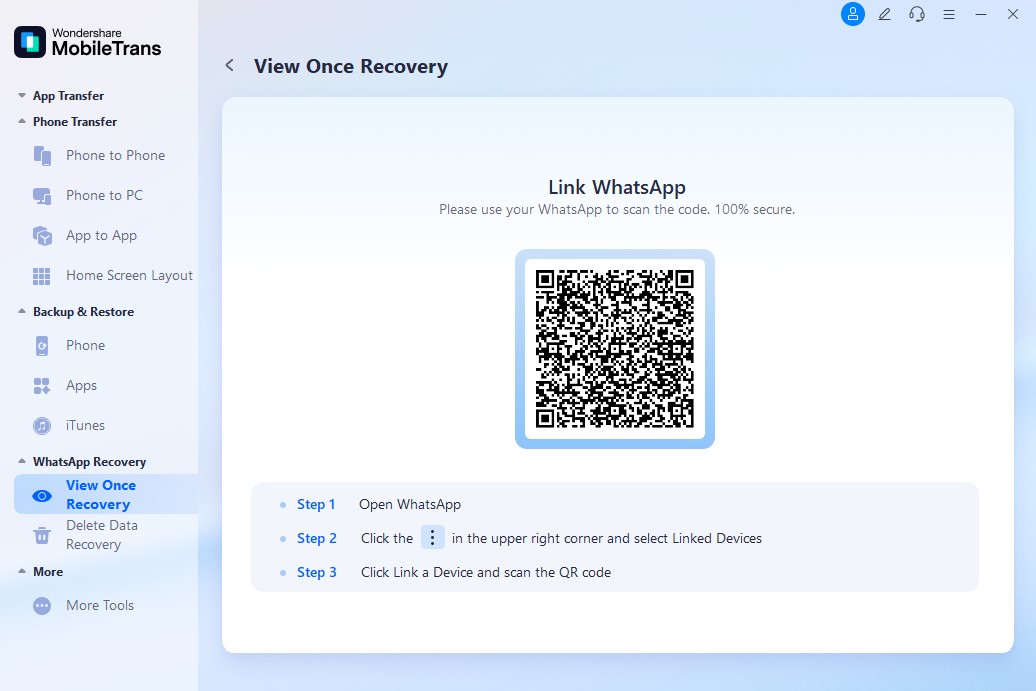
Step 3. Download View Once WhatsApp Messages
Once the account is connected to the tool, it will display the temporary media files from the chats. Select the photos you want to recover and click the “Export” button to save the chosen files and complete the recovery process.
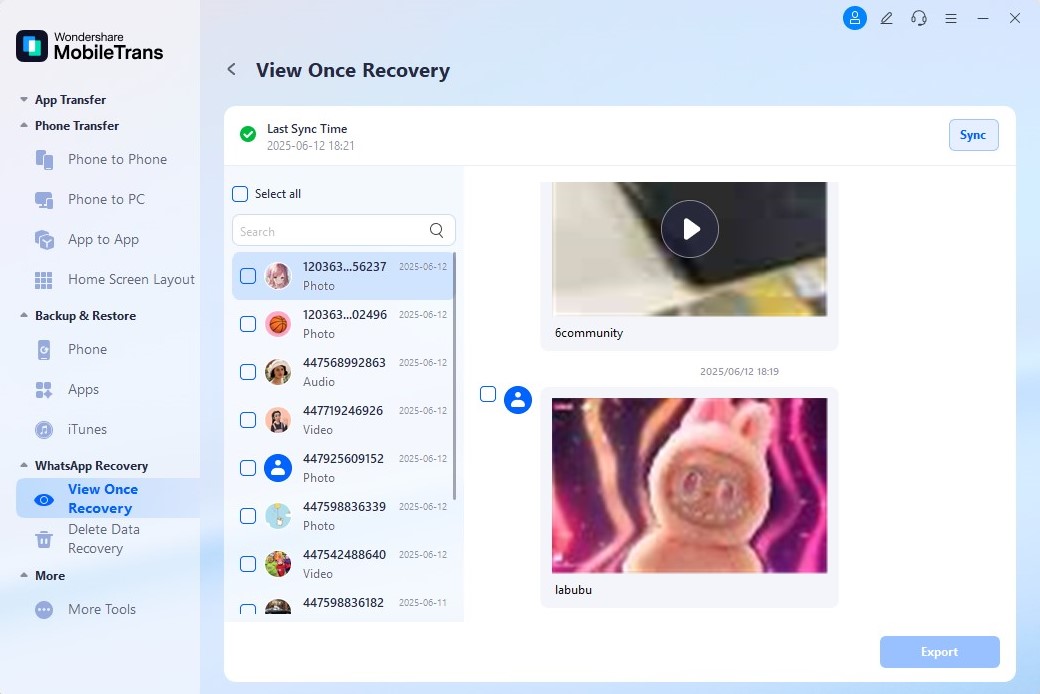
Part 4: Can You Send View Once Text Messages Like View Once Media on WhatsApp?
As this messaging app allows users to send view once photos and videos with this option, it does not offer the same feature for text messages. Currently, there is no way to make a text message viewable only once before it disappears. Instead of the view once message feature on WhatsApp, it provides another helpful option called Disappearing Messages, which can remove messages and other formats as well.
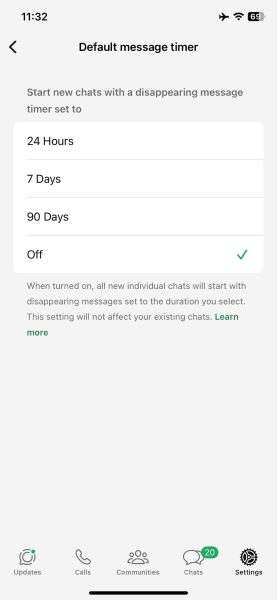
This option works differently from View Once WhatsApp; the chats do not vanish but remain visible until the set limit is reached. Users can choose a time frame based on their preferences, such as 24 hours or 90 days. In the absence of the view once feature of text messages, these disappearing messages emerge as a valuable alternative for temporary conversations.
Conclusion
In summary, the 'View Once' message feature on WhatsApp gives users more control over private content by removing it after a single view. This option enhances security by stopping downloads and blocking screenshots, thereby making shared media more secure.
However, if you have accidentally viewed them but could not figure out what they were, some tools can recover these files. Try MobileTrans today to restore your view once content of any format.
FAQs
-
Can I send View Once media in WhatsApp group chats?
This messaging app allows users to send view once photos or videos in both individual and group chats. Regarding WhatsApp groups, each participant can view the media one at a time. Once each member has opened it, the content disappears from their chat window and cannot be opened again. -
Does WhatsApp compress media sent through View Once?
Media sent through the View Once feature may be compressed automatically by the app to reduce file size and save bandwidth. As a result, the image or video quality will be slightly lowered as compared to files sent in the document option. -
Is the View Once Feature available on the desktop version?
Currently, this messaging app only supports sending and opening view once messages on mobile apps. The desktop versions do not currently support these features, so users must use their mobile phone, regardless of brand or operating system, to access this option.

